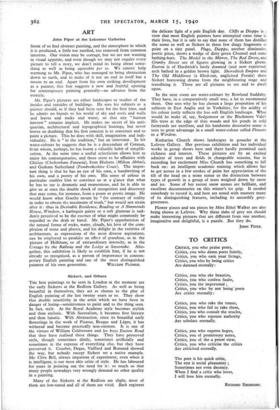Sickert, and Others
THE best paintings to be seen in London at the moment are the early Sickerts at the Redfern Gallery. As well as being beautiful in themselves, they act as chorus to the play of English painting of the last twenty years or so. They show that double sensitivity in the artist which we have been in danger of losing—sensitiveness to paint and to the thing seen. In fact, style. At the Royal Academy style becomes stylish and then stylistic. With Surrealism, it becomes first literary and then lunatic. With Abstraction, since its beautiful early flowerings in the work of Picasso, Braque and Leger, it has withered and become practically non-existent. It is one of the virtues of William Coldstream and les boys Euston Road that they have realised these things. They have preserved style, though sometimes dimly, sometimes artificially and sometimes at the expense of everything else, but they have preserved it. Courbet, Degas, Vuillard and Bonnard showed the way, but nobody except Sickert set a native example. Mr. Clive Bell, always impatient of experiment, even when it is intelligent, is our most able critic of style. He has laboured for years in pointing out the need for it : so much so that many people nowadays very wrongly demand no other quality in a painting.
Many of the . Sickerts at the Redfern are slight, most of them are low-toned and all of them are vivid. Bath registers
the delicate light of a pale English day. Cliffs at Dieppe is a view that most English painters have attempted some time in their lives, but it is safe to say that none of them has distilled the scene so well as Sickert in these few dingy fragments of paint on a tiny paneL Plage, Dieppe, another diminutive poetic piece, shows a wedge of dirty green Channel and some bathing-huts. The Model in the Mirror, The Red Dress, and Granby Street are of figures glowing in a Sickert gloom. Euston is of Hardwick's lately doomed (and now reprieved) arch bathed in a golden brown light. Shoreditch Empire and The Old Middlesex (a filled-out, anglicised Forain) show Sicken borrowing drama from the neighbouring stage and transfixing it. These are all pictures to see and to dwell upon.
In the next room are water-colours by Rowland Suddaby. They have, in a comparatively small way, a lot to recommend them. One sees why he has chosen a large proportion of his subjects in East Anglia and in Yorkshire, for the acidity of his colour justly reflects the less soft English landscape. What would he make of, say, Sedgemoor or the Blackmore Vale? His trees at the edge of thin woods and his ponds in cold farmyards are excellent, and his handsome decorative sense is seen to great advantage in a small water-colour called Flowers in a Window.
Katharine Church shows landscapes in gouache at the Lefevre Gallery. Her previous exhibition and her individual works in group shows here and there hardly promised such richness and interest. These pictures are by an excited admirer of trees and fields in changeable seasons, but in recording her excitement Miss Church has something to fall back on: an intelligent academic training which allows her to get across in a few strokes of paint her appreciation of the tilt of the head on a stone statue or the distinction between types of growth in a group of trees weighed down by snow and ice. Some of her recent. snow scenes are brilliant, and excellent documentaries on this winter's ice grip. It needed somebody to record it, and here are noted with mastery many of its distinguishing features, including its unearthly , grey- greenness.
Flower pieces and sea pieces by Miss Ethel Walker are also being shown at Lefevre. Why these slabs of grey sea should make interesting pictures that are different from one another, imaginative and delightful, is a puzzle. But they do.
JOHN PIPER.






















































 Previous page
Previous page